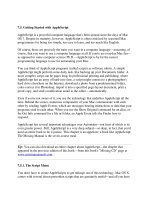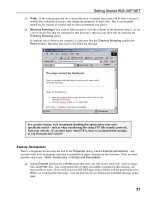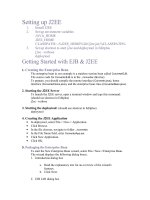Getting Started with Meteor.js JavaScript Framework pptx
Bạn đang xem bản rút gọn của tài liệu. Xem và tải ngay bản đầy đủ của tài liệu tại đây (2.4 MB, 131 trang )
www.it-ebooks.info
Getting Started with Meteor.js
JavaScript Framework
Develop modern web applications in Meteor, one of the
hottest new JavaScript platforms
Isaac Strack
BIRMINGHAM - MUMBAI
www.it-ebooks.info
Getting Started with Meteor.js JavaScript Framework
Copyright © 2012 Packt Publishing
All rights reserved. No part of this book may be reproduced, stored in a retrieval
system, or transmitted in any form or by any means, without the prior written
permission of the publisher, except in the case of brief quotations embedded in
critical articles or reviews.
Every effort has been made in the preparation of this book to ensure the accuracy
of the information presented. However, the information contained in this book is
sold without warranty, either express or implied. Neither the author, nor Packt
Publishing, and its dealers and distributors will be held liable for any damages
caused or alleged to be caused directly or indirectly by this book.
Packt Publishing has endeavored to provide trademark information about all of the
companies and products mentioned in this book by the appropriate use of capitals.
However, Packt Publishing cannot guarantee the accuracy of this information.
First published: December 2012
Production Reference: 1201212
Published by Packt Publishing Ltd.
Livery Place
35 Livery Street
Birmingham B3 2PB, UK
ISBN 978-1-78216-082-3
www.packtpub.com
Cover Image by Asher Wishkerman ()
www.it-ebooks.info
Credits
Author
Isaac Strack
Reviewers
Arturas Lebedevas
Gabriel Manricks
Acquisition Editor
Wilson D'souza
Commissioning Editor
Ameya Sawant
Technical Editors
Veronica Fernandes
Dipesh Panchal
Lubna Shaikh
Project Coordinator
Amigya Khurana
Proofreader
Chris Smith
Indexer
Monica Ajmera Mehta
Graphics
Aditi Gajjar
Production Coordinator
Melwyn D'sa
Cover Work
Melwyn D'sa
www.it-ebooks.info
About the Author
Isaac Strack, as a Design Technologist for Adobe Systems, actively researches,
develops, and contributes to emerging device and Internet technologies,
incorporating these new technologies into the Adobe Digital Media and Digital
Marketing product lines. He is on the board of directors for the Wasatch Institute of
Technology, a computer science high school located in Utah that is changing the face
of education through an Agile-based teaching methodology, which emphasizes
real-life technology skills and STEM education.
Isaac worked for the Service Technologies group at eBay for over 11 years, where he
was on the forefront of AJAX, .NET, and web-related technologies. While at eBay, he
earned a web technology patent, and is one of the original developers of the Listing
Violation Inspection System (LVIS), used to monitor and regulate auctions and
member-to-member transactions.
Isaac has a passion for technology and design, and conveys that passion through
his contributions online and in his local community. Despite his experiences to the
contrary, he's still naive enough to believe what Steve Jobs said, "If you have a good
idea and a little moxie, you can change the world."
I want to thank my four wonderful daughters, for teaching me
what true, unconditional love is, and for making me feel young and
happy, even on cold winter days. I want to thank my wife, Kirsten,
for encouraging me to never give up on my stupid, stupid dreams,
and for being so supportive and sacricing during the making of
this book. I'm grateful to my employer, Adobe Systems, and my
manager, Joel Den Engelsen, who continually support me, and have
given me my dream job. Lastly, I want to thank my Heavenly Father,
for my talents and blessings, and for the love/passion I have for
learning new, amazing things. I truly am better than I deserve, and
I am grateful for the peace in my heart, despite my best efforts to
ruin everything.
www.it-ebooks.info
About the Reviewers
Arturas Lebedevas is a Software Developer who has been working on various
projects in both Lithuania and Ireland. Previously, he was the co-founder and CTO
of an Irish legal startup LawSimply, where he used Node.js extensively along with
MongoDB.
Currently he is doing software consultancy focusing mainly on using Meteor
framework, and has been an active member of the Meteor framework community
contributing to Stack Overow.
I would like to thank to my mother who supports me in all my
decisions.
Gabriel Manricks is a Software/Web Developer born in Montreal, Canada.
He learned his rst programming language at the age of 12 (C++), and went on
to graduate in programming science.
In addition to programming, Gabriel's hobbies include electronics and crafts;
basically anything involving taking things apart, seeing how they work, and
putting them back together.
Currently Gabriel is a Staff Writer for NetTuts+, where he enjoys learning and
teaching cutting-edge web technologies.
www.it-ebooks.info
www.PacktPub.com
Support les, eBooks, discount offers
and more
You might want to visit www.PacktPub.com for support les and downloads related
to your book.
Did you know that Packt offers eBook versions of every book published, with PDF and ePub
les available? You can upgrade to the eBook version at www.PacktPub.com and as a print
book customer, you are entitled to a discount on the eBook copy. Get in touch with us at
for more details.
At www.PacktPub.com, you can also read a collection of free technical articles, sign up for a
range of free newsletters and receive exclusive discounts and offers on Packt books and eBooks.
Do you need instant solutions to your IT questions? PacktLib is Packt's online digital
book library. Here, you can access, read and search across Packt's entire library of books.
Why Subscribe?
• Fully searchable across every book published by Packt
• Copy and paste, print and bookmark content
• On demand and accessible via web browser
Free Access for Packt account holders
If you have an account with Packt at www.PacktPub.com, you can use this to access
PacktLib today and view nine entirely free books. Simply use your login credentials for
immediate access.
www.it-ebooks.info
Table of Contents
Preface 1
Chapter 1: Setup and Installation 7
Installing with curl 7
Loading an example application 9
Selecting your le location 9
Loading the example application 10
Starting the example application 10
Previewing the application 10
Help! I made too many changes! 11
Making code changes 12
Changing from todos to items 12
Summary 14
Chapter 2: Reactive Programming… It's Alive! 15
Creating the Lending Library 15
Creating the base application 16
Creating a collection 18
Fun with the browser console 19
Adding some data 20
Displaying collections in HTML 21
Cleaning up 25
Creating a reaction 28
Multiple clients 29
Summary 30
Chapter 3: Why Meteor Rocks! 31
Modern web applications 31
The origin of the web app (client/server) 31
The rise of the machines (MVC) 32
The browser grows up (MVVM) 33
www.it-ebooks.info
Table of Contents
[ ii ]
A giant Meteor appears! 35
Cached and synchronized data (the model) 35
Templated HTML (the view) 37
Meteor's client code (the View-Model) 39
Let's create some templates 40
Summary 46
Chapter 4: Templates 47
A new HTML template 47
Gluing it all together 51
Our items View-Model 51
Additional view states 54
Adding events 57
Model updates 61
Style updates 64
Summary 67
Chapter 5: Data, Meteor Style! 69
Document-oriented storage 69
But why not use a relational database 70
MongoDB 71
Using direct commands 72
Broadcasting changes 75
Published events 75
Conguring publishers 76
Turning off autopublish 77
Listing categories 78
Listing items 81
Checking your streamlined data 82
Summary 84
Chapter 6: Application and Folder Structure 85
Client and server folders 85
Public folder 89
Security and accounts 91
Removing insecure 91
Adding an admin account 92
Granting admin permissions 95
Customizing results 98
Modifying Meteor.publish() 98
Adding owner privileges 99
Enabling multiple users 100
Summary 102
www.it-ebooks.info
Table of Contents
[ iii ]
Chapter 7: Packaging and Deploying 103
Third-party packages 103
Listing available packages 103
Bundling your application 105
Deploying to Meteor's servers 106
Updating Meteor's servers 107
Using your own hostname 107
Deploying to a custom server 107
Server setup 108
Deploying your bundle 108
Optional – different platform 109
Running your application 109
Summary 111
Index 113
www.it-ebooks.info
www.it-ebooks.info
Preface
We live in amazing times. Advances in medicine, communication, physics,
and all other scientic elds provide us with opportunities to create things
that were literally impossible to create only a short while ago.
And yet, we aren't easily amazed. We've come to expect wondrous advances, and
therefore what was once amazing becomes…well…expected. It's a rare thing, indeed,
to nd something that takes us by surprise. Something that renews that childhood
sense of wonder we all secretly want back, because it was stolen from us.
Well, prepare to regain some of that wonder. A dedicated group of computer
scientists who are determined to make something wondrous have created a
new JavaScript platform called Meteor. You may be thinking, "A new JavaScript
platform? That's nothing special." And if that's all Meteor was, you'd be correct,
but fortunately for you, that's not the end of the story.
Meteor is a reactive, simple, and powerful application platform, capable of
producing sophisticated, robust web applications with just a few lines of code.
In the context of web applications, it is state-of-the-art. Using established, proven
development design patterns, Meteor takes all the difcult and mundane parts of
building a web application and does them all for you. You get to focus on building
a solid application with all the latest innovations such as reactive programming,
templates, plugins, and client-side caching/synchronization. You get to do all of this
without getting bogged down in the usual time-wasting activities, such as writing
yet-another-database-interface, or learning a new templating engine.
And the best part is, it's simple to learn. Amazingly simple. You will see an application
come to life right before your eyes, and when you look back at the number of lines of
code it took to create, and compare it to the traditional methods of development, you
may actually nd yourself saying "wow" or "how did they do that?"
www.it-ebooks.info
Preface
[ 2 ]
This book will walk you through the major features of Meteor, and show you how
to create an application from scratch. By the end of the book, you will have created
a working, useful application, and you will have a solid understanding of what makes
Meteor different. It may sound like hyperbole, but if you're open to the idea that
something innovative and unexpected can qualify as amazing, then prepare to
be amazed!
What this book covers
Chapter 1, Setup and Installation, gets you up and running with Meteor in just
a few minutes, and shows how quickly and easily you can build a fully functional,
useful application.
Chapter 2, Reactive Programming… It's Alive!, teaches you all about reactive
programming, and how you can leverage reactivity in Meteor to create amazing,
responsive applications.
Chapter 3, Why Meteor Rocks!, helps you to gain an understanding of the design
patterns Meteor uses, and shows examples of these powerful patterns in action.
Chapter 4, Templates, teaches you about Meteor templates in depth, and how to use
templates to lay the groundwork for your Lending Library application.
Chapter 5, Data, Meteor Style!, helps you to discover how Meteor handles data,
making an enterprise-level application incredibly simple and robust. It also helps
you to implement Meteor's data handling quickly and effectively in your application.
Chapter 6, Application and Folder Structure, shows what changes you can make
to the default conguration to make your application more secure, extensible,
and user-friendly.
Chapter 7, Packaging and Deploying, helps you to become an expert on Meteor's
packaging system, including how to include many popular third-party frameworks.
Learn how to deploy a Meteor application to your development, testing, and
production environments.
What you need for this book
To run the examples in the book, the following software will be required:
• Operating System:
° Mac: OS X 10.6 and above (
)
www.it-ebooks.info
Preface
[ 3 ]
° Linux: x86 or x86_64, Debian () and Red
Hat-based systems ()
• Meteor: Version 0.5.0 or above (
/>Who this book is for
This book is for an application developer, designer, or analyst with a decent
understanding of HTML and JavaScript, and who wants to learn about Meteor,
and the new movement inside the JavaScript community towards fully-functional,
robust web applications.
If you are looking for a step-by-step approach to understanding how and when
to use one of the latest and most innovative web technologies in your application
development projects, this book is for you.
Conventions
In this book, you will nd a number of styles of text that distinguish between
different kinds of information. Here are some examples of these styles, and an
explanation of their meaning.
Code words in text are shown as follows: "We've already created our categories
through the use of the
categories template."
A block of code is set as follows:
<body>
<div id="lendlib">
<div id="categories-container">
{{> categories}}
</div>
<div id="list">
{{> list}}
</div>
</div>
</body>
When we wish to draw your attention to a particular part of a code block,
the relevant lines or items are set in bold:
<body>
<div id="lendlib">
<div id="categories-container">
www.it-ebooks.info
Preface
[ 4 ]
{{> categories}}
</div>
<div id="list">
{{> list}}
</div>
</div>
</body>
Any command-line input or output is written as follows:
> meteor remove autopublish
New terms and important words are shown in bold. Words that you see on
the screen, in menus or dialog boxes for example, appear in the text like this:
"Before we celebrate, go ahead and click on the Clothes category."
Warnings or important notes appear in a box like this.
Tips and tricks appear like this.
Reader feedback
Feedback from our readers is always welcome. Let us know what you think about
this book—what you liked or may have disliked. Reader feedback is important for
us to develop titles that you really get the most out of.
To send us general feedback, simply send an e-mail to
,
and mention the book title via the subject of your message.
If there is a topic that you have expertise in and you are interested in either writing
or contributing to a book, see our author guide on
www.packtpub.com/authors.
Customer support
Now that you are the proud owner of a Packt book, we have a number of things
to help you to get the most from your purchase.
www.it-ebooks.info
Preface
[ 5 ]
Downloading the example code
You can download the example code les for all Packt books you have purchased
from your account at . If you purchased this book
elsewhere, you can visit and register to have
the les e-mailed directly to you.
Errata
Although we have taken every care to ensure the accuracy of our content, mistakes
do happen. If you nd a mistake in one of our books—maybe a mistake in the text or
the code—we would be grateful if you would report this to us. By doing so, you can
save other readers from frustration and help us improve subsequent versions of this
book. If you nd any errata, please report them by visiting ktpub.
com/support
, selecting your book, clicking on the errata submission form link, and
entering the details of your errata. Once your errata are veried, your submission
will be accepted and the errata will be uploaded on our website, or added to any list
of existing errata, under the Errata section of that title. Any existing errata can be
viewed by selecting your title from />Piracy
Piracy of copyright material on the Internet is an ongoing problem across all media.
At Packt, we take the protection of our copyright and licenses very seriously. If you
come across any illegal copies of our works, in any form, on the Internet, please
provide us with the location address or website name immediately so that we can
pursue a remedy.
Please contact us at
with a link to the suspected
pirated material.
We appreciate your help in protecting our authors, and our ability to bring you
valuable content.
Questions
You can contact us at if you are having a problem with
any aspect of the book, and we will do our best to address it.
www.it-ebooks.info
www.it-ebooks.info
Setup and Installation
Under the hood, Meteor is really just a bunch of les and scripts, designed to make
the building of a web application easier. That's a terrible way to describe something
so elegant, but it helps us better understand what we're using.
After all, Mila Kunis is really just a bunch of tissue wrapped around bone, with some
vital organs inside. I know you hate me now for that description, but you get the
point. She's beautiful. So is Meteor. But it doesn't do us any good to just leave it at
that. If we want to reproduce that type of beauty on our own, we have to understand
what's really going on.
So, les and scripts… We're going to walk through how to get the Meteor package
properly installed on your Linux or Mac OS X system, and then see that package of
les and scripts in action. Note that Windows support is coming, but as of the time
of this writing, only the Linux and Mac versions are available.
In this chapter, you will learn:
• Downloading and installing Meteor via curl
• Loading an example application
• Making changes and watching Meteor in action
Installing with curl
There are several ways to install a package of les and scripts. You can manually
download and transfer les, you can use a pretty installation wizard/package with
lots of "next" buttons, or you can do what real developers do, and use the command
line. It puts hair on your chest. Which, now that I think about it, may not be a very
desirable thing. Okay, no hair; I lied. But still, you want to use the command line,
trust me. Trust the person that just lied to you.
www.it-ebooks.info
Setup and Installation
[ 8 ]
curl (or cURL if you want to get fancy) is a command-line tool used to transfer les
and run scripts, using standard URL locations. You probably already knew that, or
you probably don't care. Either way, we've described it and we're now moving on to
using it.
Open a terminal window or the command line, and enter the following:
$ curl | /bin/sh
Downloading the example code
You can download the example code les for all Packt books you
have purchased from your account at ktPub.
com. If you purchased this book elsewhere, you can visit http://
www.PacktPub.com/support and register to have the les
e-mailed directly to you.
This will install Meteor on your system. curl is the command to go and fetch the
script. is the URL/location of the script, and /bin/sh
is, of course, the location of the script interpreter "Shell", which will run the script.
Once you've run this script, assuming you have an Internet connection and the
proper permissions, you will see the Meteor package download and install:
The key thing we're looking for in the preceding installation text is the location
of Meteor:
Installing Meteor to /usr/local/meteor
www.it-ebooks.info
Chapter 1
[ 9 ]
This location will vary depending on if you're running this in Linux or Mac OS X,
but it puts Meteor into a location where you can then access the Meteor script from
anywhere else. This will become important in a minute. For now, let's see what kind
of friendly message we get when the Meteor installation is nished:
Meteor installed! To get started fast:
$ meteor create ~/my_cool_app
$ cd ~/my_cool_app
$ meteor
Or see the docs at:
docs.meteor.com
Great! You've successfully installed Meteor, and you're on your way to creating your
rst Meteor web application!
You should bookmark as an invaluable
reference moving forward.
Loading an example application
The wonderful people at Meteor have included several example applications, which
you can quickly create and play with, helping you get a better idea of what Meteor is
capable of.
For the application we will build, the
todos example is the closest t, so we'll go
ahead and build off of that example. We'll be using the command line again, so
awesome news if you still have it open! If not, open a terminal window, and follow
these steps.
Selecting your le location
So we can remember where they are later, we'll put all the les for this book
in the ~/Documents/Meteor folder. We need to create that folder:
$ mkdir ~/Documents/Meteor
Now, we want to be in that directory:
$ cd ~/Documents/Meteor
www.it-ebooks.info
Setup and Installation
[ 10 ]
Loading the example application
We can now use the Meteor create command with the example parameter
to create a local copy of the todos example application:
$ meteor create –-example todos
As with the Meteor installation itself, the create command script has a friendly
success message:
todos: created.
To run your new app:
cd todos
meteor
How handy, there are even instructions on what to do next! Let's go ahead and do
what our good command-line friend is telling us.
Starting the example application
To start up a Meteor application, we need to be in the application directory itself.
This is because Meteor is looking for the startup les, HTML, and JavaScript needed
to run the application. Those are all found in the application folder, so let's go there:
$ cd todos
This puts us in the ~/Documents/Meteor/todos folder, and we're ready to run
the application:
$ meteor
Yes, that's it. Meteor takes care of everything for us, reading all the les and scripts,
and setting up the HTTP listener:
[[[[[ ~/Documents/Meteor/todos ]]]]]
Running on: http://localhost:3000/
We can now take the URL we've been given (http://localhost:3000/), and check
out the example application in a web browser.
Previewing the application
Open your favorite web browser (we'll be using Chrome, but any modern, updated
browser will work) and navigate to http://localhost:3000/.
www.it-ebooks.info
Chapter 1
[ 11 ]
You should see the following screen, with a few todo lists already added:
You can go ahead and poke around the application if you'd like. Add a new item to
a list, change lists, add a new tag, or mark items as complete. Go nuts, friend! Any
changes we make in the future won't match exactly what you will have on your
screen if you make a lot of changes, but you'll be able to follow along just ne.
Help! I made too many changes!
Do you fear change, and want your screens to look exactly like our sample screens?
No problem, just start with a clean instance.
1. At the command line:
Ctrl + C
2. This stops the running application. Now go up one directory:
$ cd
3. Remove the todos application:
$ rm –R todos
4. Create the todos example application again:
$ meteor create example todos
5. Change to the new directory, start Meteor, and you're good to go:
$ cd todos
$ meteor
www.it-ebooks.info
Setup and Installation
[ 12 ]
Making code changes
Okay, we've got our application up and running in the browser, and we now want
to see what happens when we make some code changes.
One of the best features of Meteor is reactive programming and hot code pushes.
The following is from
/>Meteor embraces the concept of reactive programming. This means
that you can write your code in a simple imperative style, and the
result will be automatically recalculated whenever data changes that
your code depends on.
Put even more simply, this means that any changes you make to the HTML,
JavaScript, or database are automatically picked up and propagated.
You don't have to restart the application or even refresh your browser. All changes
are incorporated in real time, and the application reactively accepts those changes.
Let's see an example.
Changing from todos to items
As we learn the ins and outs of Meteor, we want to build a working application:
something useful, and complex enough so that we can experience all the major
features of Meteor. We will be building a Lending Library, where we can keep track
of what items we have (for example, Mad Men Season 1), organize these items into
categories (for example, DVDs), and keep track of the people to whom we have lent
the items.
To see the beginnings of this, let's change the lists of todos to lists of items, and let's
change the word list to category, because that sounds much more awesome.
First, make sure the application is up and running. You can do this by having an
open browser window, pointing to
http://localhost:3000/. If the app is running,
you'll see your todos application. If your application isn't up and running, make
sure to follow the steps previously given in the section Starting the example application.
Now, we need to open and edit the
todos.html le. With your favorite text/code
editor, open ~/Documents/Meteor/todos/client/todos.html.
www.it-ebooks.info
Chapter 1
[ 13 ]
1. Change title in the head section:
<head>
<title>Items</title>
</head>
2. Go ahead and save the le, and look at your web browser. The page
will automatically refresh, and you'll see the title change from Todos:
The title will now display the word Items:
This is Meteor in action! It's monitoring any changes to les, and when it sees that
a le has changed, it's telling your browser that a change has been made, and that it
should refresh itself to get the latest version.
Moving forward, we're going to build an application from scratch, so we don't want
to make too many changes to this example application. However, we still want to at
least clean up the other visible references to
todo and list.
1. Back in your text editor, make the following change to the
<h3> tag
(located approximately around line 20):
<template name="lists">
<h3>Item Categories</h3>
Save this change, and you'll see the change reected in your browser. The left
header originally displayed the following text:
www.it-ebooks.info
Setup and Installation
[ 14 ]
It will now have changed to the following:
2. We need to deal with one more area, and we've successfully turned our
todos application into an items application.
If you noticed, in the bottom of the Categories list, the open box currently
says New list:
We need to change this to say New category instead. Make the following
code change on line 39:
<div id="createList">
<input type="text" id="new-list" placeholder="New category" />
</div>
3. Save your changes, and check your work:
Summary
Great success! In this chapter, you've successfully installed the Meteor framework,
loaded an example application, and made changes to that application, becoming
familiar with le changes and the reactive nature of Meteor. You are now ready
to start building your very own Meteor application, and learn more of the elegant
features and advantages that come from developing with Meteor.
www.it-ebooks.info









